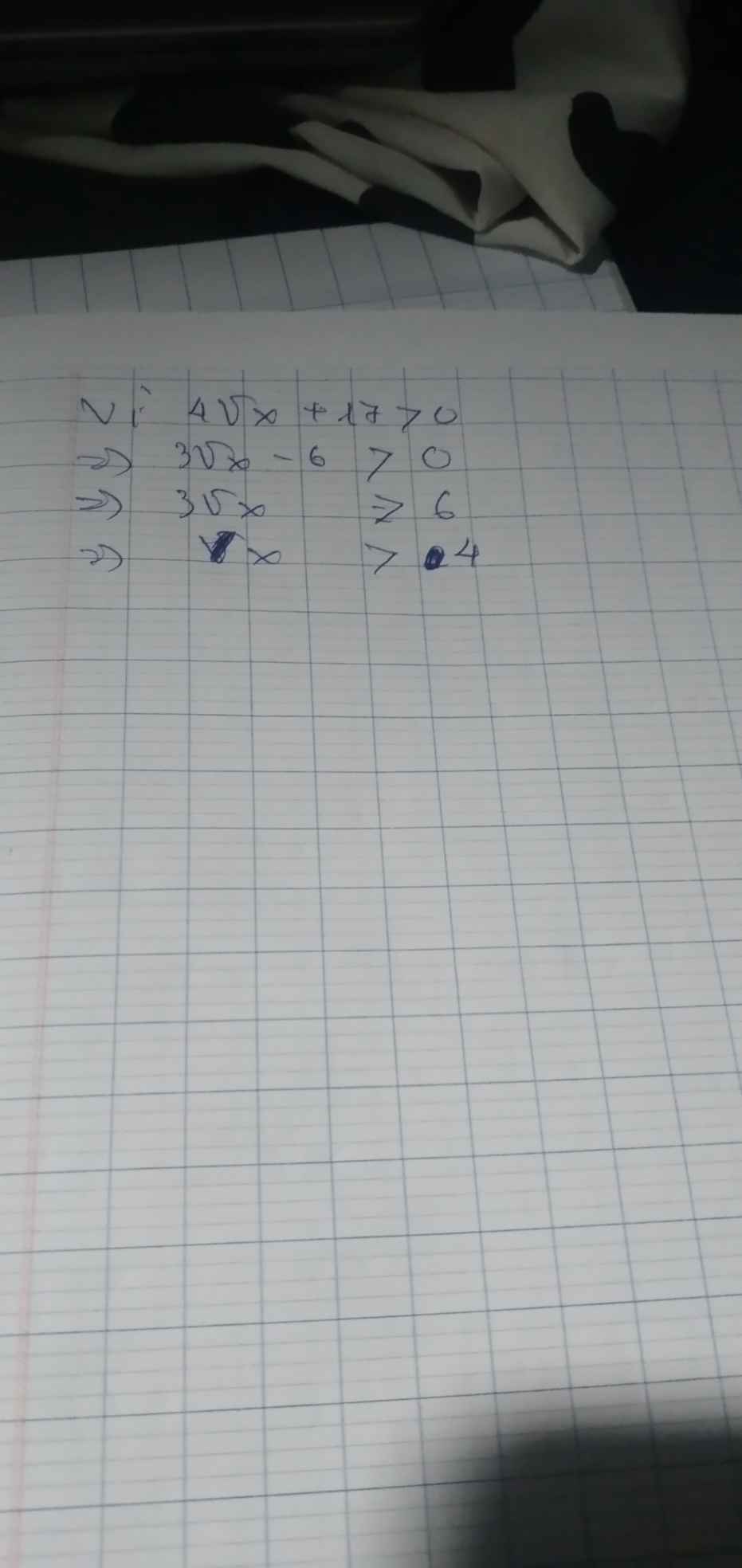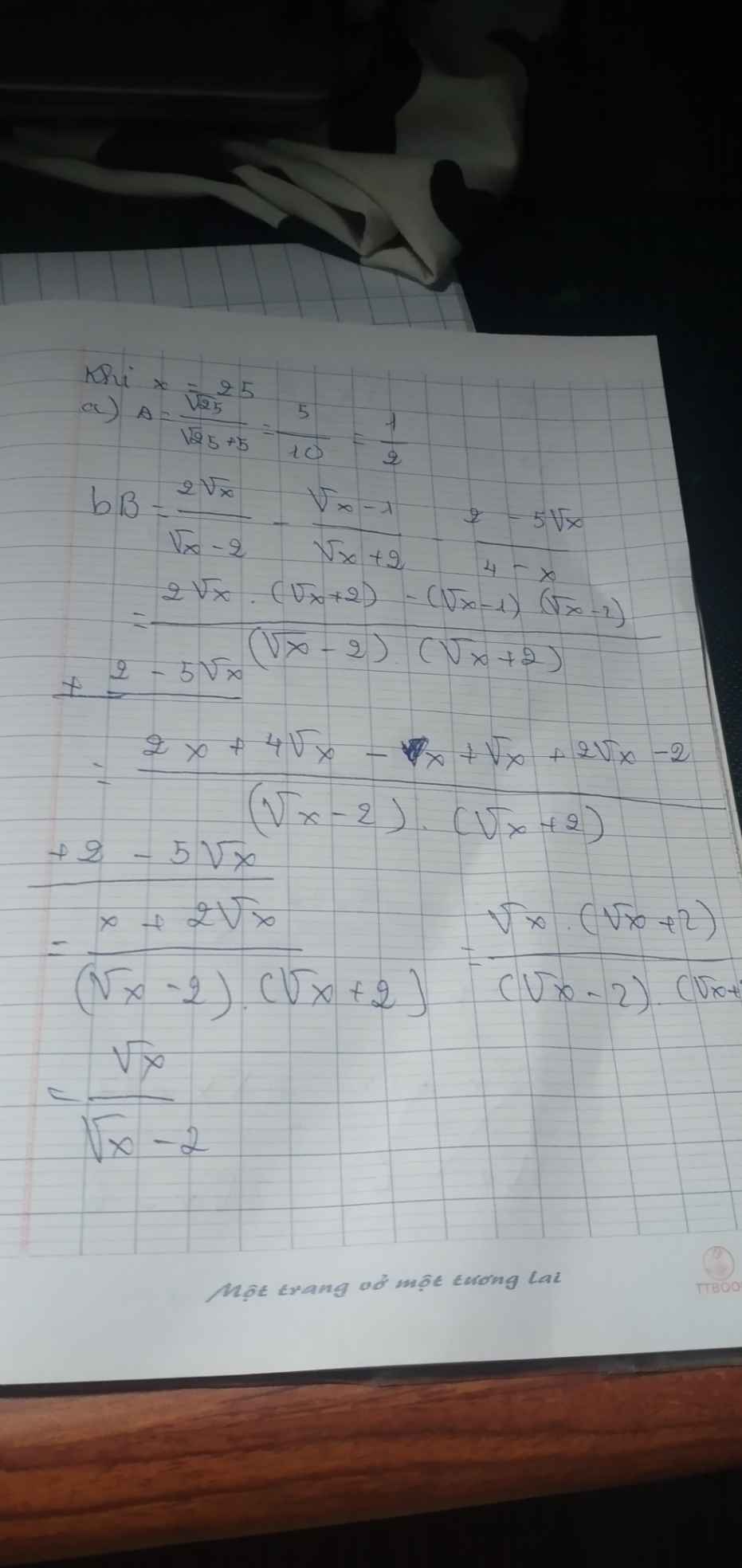Hãy nhập câu hỏi của bạn vào đây, nếu là tài khoản VIP, bạn sẽ được ưu tiên trả lời.

P=A*B
\(=\dfrac{x-7}{\sqrt{x}}\cdot\dfrac{\sqrt{x}}{\sqrt{x}+2}=\dfrac{x-7}{\sqrt{x}+2}\)
P nguyên
=>x-4-3 chia hết cho căn x+2
=>căn x+2 thuộc Ư(-3)
=>căn x+2=3
=>x=1

a: Thay \(x=\dfrac{1}{4}\) vào A, ta được:
\(A=\left(\dfrac{1}{2}+1\right):\left(\dfrac{1}{2}-2\right)=\dfrac{3}{2}:\dfrac{-3}{2}=-1\)
b: Ta có: \(B=\dfrac{\sqrt{x}+2}{\sqrt{x}-3}+\dfrac{\sqrt{x}-8}{x-5\sqrt{x}+6}\)
\(=\dfrac{x-4+\sqrt{x}-8}{\left(\sqrt{x}-3\right)\left(\sqrt{x}-2\right)}\)
\(=\dfrac{x+\sqrt{x}-12}{\left(\sqrt{x}-3\right)\left(\sqrt{x}-2\right)}\)
\(=\dfrac{\sqrt{x}+4}{\sqrt{x}-2}\)
c: Để B là số tự nhiên thì \(\sqrt{x}+4⋮\sqrt{x}-2\)
\(\Leftrightarrow\sqrt{x}-2\in\left\{1;2;3;6\right\}\)
\(\Leftrightarrow\sqrt{x}\in\left\{3;4;5;8\right\}\)
hay \(x\in\left\{16;25;64\right\}\)

\(P=A:B=\dfrac{1-\sqrt{x}}{\sqrt{x}-2}:\dfrac{2\sqrt{x}}{\sqrt{x}-2}=\dfrac{1-\sqrt{x}}{2\sqrt{x}}\)
Có: \(\left|P+1\right|< 3P\left(ĐK:x>0\right)\)
\(\Leftrightarrow\left|\dfrac{1-\sqrt{x}}{2\sqrt{x}}+1\right|< 3.\dfrac{1-\sqrt{x}}{2\sqrt{x}}\\ \Leftrightarrow\left|\dfrac{1-\sqrt{x}+2\sqrt{x}}{2\sqrt{x}}\right|< \dfrac{3-3\sqrt{x}}{2\sqrt{x}}\\ \Leftrightarrow\left|\dfrac{\sqrt{x}+1}{2\sqrt{x}}\right|< \dfrac{3-3\sqrt{x}}{2\sqrt{x}}\)
Vì \(\sqrt{x}\ge0\Rightarrow\sqrt{x}+1\ge1\) nên:
\(\left|\dfrac{\sqrt{x}+1}{2\sqrt{x}}\right|< \dfrac{3-3\sqrt{x}}{2\sqrt{x}}\\ \Leftrightarrow\dfrac{\sqrt{x}+1-3+3\sqrt{x}}{2\sqrt{x}}< 0\\ \Leftrightarrow\dfrac{4\sqrt{x}-2}{2\sqrt{x}}< 0\\ \Leftrightarrow\dfrac{2\sqrt{x}-1}{\sqrt{x}}< 0\\ \Rightarrow\left\{{}\begin{matrix}\sqrt{x}>0\\2\sqrt{x}-1< 0\end{matrix}\right.\\ \Rightarrow\left\{{}\begin{matrix}x>0\\x< \dfrac{1}{4}\end{matrix}\right.\)
\(\Rightarrow0< x< \dfrac{1}{4}\)

\(P=A.B=\dfrac{\sqrt{x}}{\sqrt{x}+1}.\dfrac{\sqrt{x}+1}{\sqrt{x}-2}\)
\(=\dfrac{\sqrt{x}}{\sqrt{x}-2}\)
Ta có : \(\left|P\right|-P=0\) \(\Leftrightarrow\left|P\right|=P\Leftrightarrow\left|\dfrac{\sqrt{x}}{\sqrt{x}-2}\right|=\dfrac{\sqrt{x}}{\sqrt{x}-2}\)
\(+TH_1:x\ge0\Leftrightarrow\dfrac{\sqrt{x}}{\sqrt{x}-2}=\dfrac{\sqrt{x}}{\sqrt{x}-2}\) (luôn đúng)
\(+TH_2:x< 0\Leftrightarrow-\dfrac{\sqrt{x}}{\sqrt{x}-2}=\dfrac{\sqrt{x}}{\sqrt{x}-2}\)
\(\Leftrightarrow-\dfrac{\sqrt{x}}{\sqrt{x}-2}-\dfrac{\sqrt{x}}{\sqrt{x}-2}=0\)
\(\Leftrightarrow-2.\left(\dfrac{\sqrt{x}}{\sqrt{x}-2}\right)=0\)
\(\Leftrightarrow x=0\)

c,M = \(\dfrac{A}{B}\) = \(\dfrac{\sqrt{x}-4}{\sqrt{x}+5}\) : \(\dfrac{\sqrt{x}+3}{\sqrt{x}+5}\)
M = \(\dfrac{A}{B}\) = \(\dfrac{\sqrt{x}-4}{\sqrt{x}+5}\) \(\times\) \(\dfrac{\sqrt{x}+5}{\sqrt{x}+3}\)
M = \(\dfrac{A}{B}\) = \(\dfrac{\sqrt{x}-4}{\sqrt{x}+3}\) = \(\dfrac{\sqrt{x}+3-7}{\sqrt{x}+3}\)
M = 1 - \(\dfrac{7}{\sqrt{x}+3}\)
M \(\in\) Z ⇔ 7 ⋮ \(\sqrt{x}\) + 3 vì \(\sqrt{x}\) ≥ 0 ⇒ \(\sqrt{x}\) + 3 ≥ 3 ⇒ 0< \(\dfrac{7}{\sqrt{x}+3}\) ≤ \(\dfrac{7}{3}\)
⇒ M Đạt giá trị nguyên lớn nhất ⇔ \(\dfrac{7}{\sqrt{x}+3}\) đạt giá trị nguyên nhỏ nhất ⇔ \(\dfrac{7}{\sqrt{x}+3}\) = 1 ⇔ \(\sqrt{x}\) + 3 = 7 ⇔ \(\sqrt{x}\) = 4 ⇔ \(x\) = 16
Mnguyên(max) = 1 - 1 = 0 xảy ra khi \(x\) = 16

Ta có :
\(A.B=\dfrac{24}{\sqrt{x}+6}.\dfrac{\sqrt{x}+6}{\sqrt{x}-6}\)
\(=\dfrac{24}{\sqrt{x}-6}\)
Để \(AB\le12\Leftrightarrow\dfrac{24}{\sqrt{x}-6}\le12\)
\(\Leftrightarrow\dfrac{24-12\left(\sqrt{x}-6\right)}{\sqrt{x}-6}\le0\)
\(\Leftrightarrow24-12\sqrt{x}+72\le0\)
\(\Leftrightarrow-12\sqrt{x}\le-96\)
\(\Leftrightarrow\sqrt{x}\ge8\)
\(\Leftrightarrow x\ge64\)
Vậy \(x\ge64\) thì \(AB\le12\)

c: P nguyên
=>căn x+1+4 chia hết cho căn x+1
=>căn x+1 thuộc {1;2;4}
=>x thuộc {1;9}



Ta có : \(P=3A+2B\)
\(=\dfrac{2\sqrt{x}}{\sqrt{x}+2}+\dfrac{3}{\sqrt{x}+2}=\dfrac{2\sqrt{x}+3}{\sqrt{x}+2}.\)
\(\Rightarrow P=\dfrac{2\left(\sqrt{x}+2\right)-1}{\sqrt{x}+2}=2-\dfrac{1}{\sqrt{x}+2}\)
Do \(x\ge0\Rightarrow\sqrt{x}+2\ge0\)
\(\Rightarrow-\dfrac{1}{\sqrt{x}+2}\ge-1\)
\(\Rightarrow P=2-\dfrac{1}{\sqrt{x}+2}\ge-1+2=1.\)
Vậy : \(MinP=1.\) Dấu đẳng thức xảy ra khi và chỉ khi \(x=0.\)